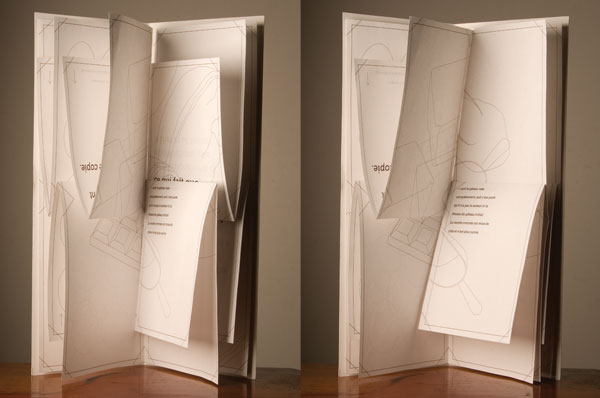After seeing a lot of visualisations and animations that represent something it occurred to me that they are no more that metaphorical representations of what they stood for. With this in mind I began to look for works that were more abstract and thought provoking, that would take more than a quick look over to understand them
Above is a picture of ‘Chromosome book’ by French student Avril de Perthuis (2011) who metaphorically broke down and visualised natural selection. The book is comprised of many pages that can be arranged in many different possible combinations. Some combinations make the book more readable, but there is only one combination that enables the viewer to read the whole book. This reflects and draws similarities to natural selection in that there are many different possible gene combinations, some are better than others; however there is one that supersedes the rest and is the most effective. I found the piece highly intriguing as it is very interactive and though experimenting with the pages, you become more informed about the process of natural selection and its concept. Interactivity I think is a key area that would grant looking further into, if more than one sense is involved in learning a topic the more information there is connected to it.
Above is a live posters that animate while you are waiting in line, I thought that this was a great example of an animated 'poster' that already existed. I would think that they would be the next big thing, with corridors in school lined with different ones. If i was to develop the Ancient light project or even the hydrogen atom project then either could be used as digital posters.
It has also lead me to think about interactivity in a tactile sense - I recently had a meeting with two specialists at the university, Adam Sampson who was coding based, and James Bown who focused on the visualisation side of things. They were currently creating a system to represent and visualise how cells and chemicals would be affected by different kinds of cancer treatment, as well as past works where they would break down biological hierarchy's and make codded models of how they interact with each other. I initially had a meeting with Adam where he showed me the models of he was working on and how they could be programmed to show different behaviours and reactions. I found this really interesting as I could see the benefits of making it and how it could be used to map behaviour of a lot of things from bird flocks to bacteria. The viewer could then see how they would react in certain situations visually, enabling them to try and predict outcomes/ make observations.
Following this I had a meeting with James Bown where he showed me a recent presentation on the work he was doing on the cancer research and visualisation. It was very insightful for me to see how they were using the models they had made of cell hierarchy and how the cancer effected them, and then incorporated that into visualisation of the whole process. You could then take one chain of the cell, add a chemical reaction and see what effect it had on the cancer and the rest of the chain of command. Highly complicated stuff, but with the use of the visualisation and the body's capability of taking in so much visually it was a lot easier to take in than it would of been if it were text based.
Jonathan Harris' magical new media projects redefine storytelling from PopTech on Vimeo.
I saw this video the other day, and it made me think of the connections we have between everything, from people to objects and memories. Made me think about my work and the works of other being more like bridges to get people to connect A with B.
Another artist who strives to do the same is Ronald Forbes creates abstract artwork bringing together different aspects of some ideas and merging them with others. His work seems very poetic and metaphorical bringing mostly science and art together in abstract manners that challenge us to see where one begins and he other ends. Some images have collages of different images to define microbes or scientific ideas, yet the imagery is almost nonsensical at first glance with layer of meaning and literal layers in the paining. I want to maybe corporates more abstract models into my own work.
Ronald Forbes
I have had some ideas of abstract ways to visualise some scientific topics these include:
Elemental Flowers
looking at how i could relate the elements to different types of flowers, with petals denoting their electron number and seeds to represent their protons/neutrons
Pair of Chromosome Hares
While looking at different scientific concepts on genetics i came across a picture of Chromosomes

After a long day working I squinted at the picture and thought that they looked very much like bunny ears, so I started thinking about if you could create a concept to teach younger children about genetics using simple Bunny or Hare metaphors . This would challenge normal constraints of age demographics and when you would be taught genetics. It may be too much abstraction for very young children, but could merit looking into.



No comments:
Post a Comment